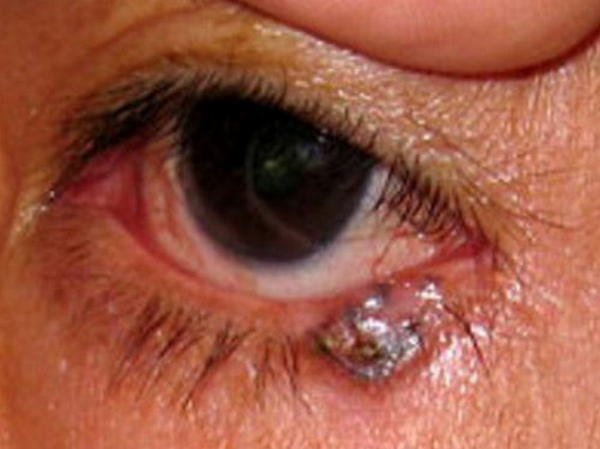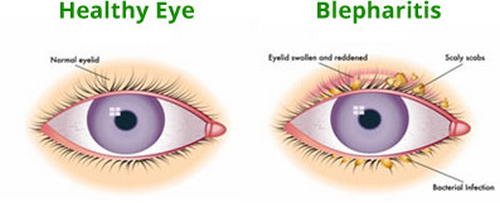Ingrown Eyelash
Last reviewed by Dr. Raj MD on January 12th, 2022.
An ingrown eyelash is a condition wherein the eyelash grows inward instead of outward. It commonly affects the adult population and can occur in either top or bottom part of the eyelid. Over time, ingrown eyelash can cause discomfort and irritation.
If left untreated could lead to a serious health condition such as blindness. The medical term for an ingrown eyelash is trichiasis. You can tell if you have an ingrown eyelash by looking at the following symptoms:
- The area surrounding the eyes becomes red and sore.
- Watery eyes
- Blurry vision (2)
- The eyelid is inflamed
- Pain and discomfort in the eye area
- Bloodshot eye appearance
- Recurrent eye infection
- Sensitivity to light (1)

Image 1: A bump on the lower eyelid, which could lead to an ingrown eyelash.
Picture Source: encrypted-tbn0.gstatic.com

Photo 2: An ingrown eyelash in the lower eyelid.
Picture Source:www.ihealthblogger.com
What causes ingrown eyelashes?
What causes eyelashes to grow inward? There is a variety of medical condition associated with an ingrown eyelash such as the following:

Image 3: A person has distichiasis in the lower eyelid.
Picture Source: img.medscapestatic.com

Photo 4: A comparison image between a healthy eye and an eye with blepharitis.
Picture Source: www.theralife.com
- Distichiasis – A person has an extra row of eyelashes, which means that the eyelashes are more than the usual. There is a tendency that the excess eyelashes will rub against the eye causing discomfort and irritation. (2, 3)
- Blepharitis – A medical term for an inflamed eyelid secondary to blockage of the meibomian gland. An inflammation of the eyelid can also be linked to an allergic reaction and bacterial infection.
- Entropion – The eyelid draws inward, which causes the eyelashes to rub against the eyeball. If left untreated could severely damage the cornea.
- Stye – It is a small bump on the eyelid. It is a rare serious condition but causes discomfort. It can get irritated too. It usually goes away on its own in a matter of weeks. A stye is bacterial in nature, which targets the hair follicle of the eyelash. Ingrown eyelash for stye causes discomfort and can get irritated over time. (3, 4)
- Trauma to the eyelid – A trauma or injury to the eyelid can significantly affect the eyes and the surrounding structures. It compromises the continuity of the eyelid. An ingrown eyelash is most likely to occur if the injury site heals in a malposition. See : Eyelid Surgery
- Autoimmune disorder – An ingrown eyelash can be linked to an autoimmune disorder. Examples of autoimmune disorder that can cause ingrown eyelash include vernal keratoconjunctivitis, Stevens-Johnson syndrome, and lupus.
- Psoriasis – It is a skin disorder characterized by thickening and scaling of the skin. The thickening of the skin can lead to mal-positioning of the eyelash. In rare instances, it causes ingrown eyelash.
- Infection – Any types of infection of the eyelid, be it a bacterial, fungal, or viral source can cause ingrown eyelash. (4, 5, 6)
How to remove ingrown eyelash?
How do ingrown eyelashes go away? What can you do to thoroughly get rid of ingrown eyelashes? The treatment approach for ingrown eyelashes depends on the underlying cause. The typical treatment methods are as follow:
Medical approach
Corticosteroids
It is prescribed to alleviate inflammation. What it does is it helps in the management of symptoms of an ingrown eyelash. The corticosteroids of choice are:
- Prednisolone
- Fluocinolone (5, 6)
What to keep in mind – Those who have an allergy to steroids, liver or kidney disease, and pregnant women should be extra careful when it comes to using corticosteroids.
Antibiotics
It is used in the treatment and management of ingrown eyelash of a bacterial cause. The antibiotics of choice include the following:
- Gentamicin cream
- Ciprofloxacin eye drops (6, 7)
Artificial tears
It is used to treat dry eyes. In the case of an ingrown eyelash, an artificial tear can help relieve irritation and alleviate discomfort. It is also helpful in reducing the possibility of corneal scarring. (6, 7, 8)
Non-conventional approach
- Epilation – It pertains to the process of removing unwanted hair from the body. It can be done in many different ways such as shaving, waxing, and electric epilation. However, these methods are not suitable eyelash hair. For ingrown eyelash, it can only be done using manual or surgical (epilation forceps). (7, 8)
- Electrolysis – A high-frequency electric current is used to get rid of ingrown eyelashes. Multiple sessions are needed to thoroughly get rid of ingrown eyelash and prevent recurrence.
- Cryotherapy – It is a procedure wherein the target hair follicle is frozen with the use of an argon gas or a liquid nitrogen. It is one of the preferred techniques because it is least traumatic and has a fast recovery time. It also permanently removes ingrown eyelashes. (7, 8, 9)
Surgical approach
It is performed in patients with multiple ingrown eyelashes.it is usually done under local anesthesia. In special cases, a general anesthesia is necessary. It can be extremely costly and invasive, but it is by far the permanent solution to multiple ingrown eyelashes. (9, 10)
Home remedies for ingrown eyelash
There are natural remedies for ingrown eyelashes and you can perform them in the comfort of your home. These are the following:
- Aloe vera – An extract of aloe vera applied to the eyelid can soothe an irritated eyelid. It does not get rid of ingrown eyelash but it is effective in alleviating the symptoms of an ingrown eyelash.
- Plucking – It is one of the cheap ways to get rid of an ingrown eyelash. However, there is always a possibility of recurrence.
- Warm compress – It soothes swollen eyelids and alleviates inflammation. It increases the flow of blood and hastens the healing process. Aside from warm compress, you can also try tea bag compress. Tea has anti-inflammatory and antibacterial property, which makes it even more effective in alleviating pain and reducing inflammation.
- Coconut oil – Its antibacterial and anti-inflammatory properties are useful in the treatment and management of eye infection. People with an ingrown eyelash are prone to infection and a coconut oil is one of the best ways to prevent infection.
- Honey – It is one of the best natural remedies for eyelid infection because of its antibacterial property and the ability to prevent infection.
- Turmeric – It is an herb-packed with medicinal properties. It has both anti-inflammatory and antibacterial properties. It cannot make the ingrown eyelash go away but it can relieve pain and alleviate inflammation. (7, 8, 9, 10)
What can you do to prevent ingrown eyelashes?
- Observe a good eye care habit.
- Make sure you remove eye makeup and contact lenses before going to bed.
- When out in the sun, you should wear sunglasses.
- Get plenty of sleep.
- Limit the use of gadget as it can strain the eyes.
- Visit your eye doctor regularly.
An ingrown eyelash is a health condition that should not be taken for granted. It can be extremely irritating and causes pain and discomfort. If left untreated, there is a possibility that it could develop into a more serious condition. Corneal scarring is possible, which could eventually lead to blindness. (2, 5, 10)
References:
- https://www.healthline.com/health/ingrown-eyelash
- https://medlicker.com/1120-ingrown-eyelash
- https://www.livestrong.com/article/70705-treat-ingrown-eyelash/
- https://www.wowremedies.com/ingrown-eyelash/
- https://www.eyedoctorophthalmologistnyc.com/treatment/ingrown-eyelash-trichiasis/
- https://byebyedoctor.com/ingrown-eyelash/
- https://www.bopss.co.uk/public-information/common-conditions/trichiasis-ingrowing-eyelashes/
- https://www.nobodyproblems.com/treat-ingrown-eyelash/
- https://mavcure.com/how-to-treat-an-ingrown-eyelash/
- http://healthfixit.com/trichiasis-or-ingrown-eyelash/